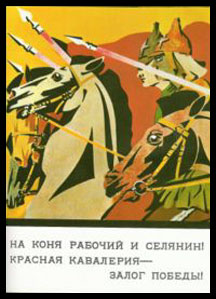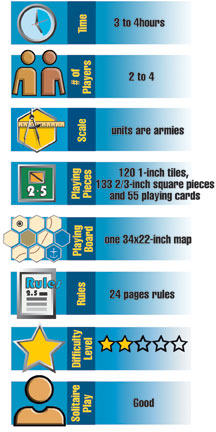| 
Life is beautiful. Let the
future generations cleanse it of all evil,
oppression and violence, and enjoy it to the
full. — Leon Trotsky, February
27th, 1940
Red Russia
The Russian Civil War 1918–1921
Between 1918 and 1921, violent upheavals
wracked the former Russian Empire. Communism,
monarchism, nationalism, anarchism and many
other -isms vied for control of the Tsar’s
domains. When the war finally ended, the “Red”
faction emerged victorious, but it was a hollow
victory. Economic output had fallen by 96
percent compared to 1913’s figures,
agriculture was down by 63 percent, and $35
billion worth of damage had been done. Millions
had died; to this day no one is exactly sure
how many.

The Konarmiya, or Red Cavalry Army,
was one of the most effective formations
in the Russian Civil War.
|
In Red Russia, designer William “Defiant
Russia” Sariego takes the popular game
system from Soldier
Kings to this decisive moment in history.
Players represent from two to five factions:
the Reds (Communists), Allied Interventionists,
Siberian Whites (monarchists), Southern Whites
or Northern Whites. The game is played in turns
representing a season of the year (three months).
It begins with the summer turn of 1918, and
ends with the conclusion of the spring 1921
turn. A full game without an Automatic Victory
is thus 12 turns long.
Players command infantry and cavalry armies,
and for some factions fleets and aircraft.
The Allied Interventionists also have a tank
unit. Leaders assist these units in movement
and combat, ranging in quality from Wrangel
of the Whites and Trotsky of the Reds on down
to the hapless Sergei Kamenev of the Reds.
As with the “Soldier” games,
the map is divided into land areas and sea
zones. Armies move on land, fleets at sea.
Each land area is rated for the amount of
money and manpower it generates each turn.
Manpower represents not just fresh recruits
for your forces, but also the things made
with human labor: food, uniforms, weapons
and so on. Money is, well, money. You expend
manpower to rebuild your forces, and money
to finance their actions. Thus you need to
hang on to areas that generate these resources
for you, and take them from the other guy.

You do that by defeating enemy armies, and
besieging enemy areas. Combat is conducted
by rolling dice, one for each attack factor.
These hits must be sustained by enemy armies
by reducing them in strength, or eliminating
them. A good general lets you roll more dice.
Each area is rated for its garrison strength;
to capture it, you have to defeat the garrison
troops through siege (in addition to driving
off any enemy armies there). The procedure
here is very similar.
Throwing a twist into all of this are random
events, shown through the 55 high-quality
playing cards. The universe is
loaded with random elements; life does not
unfold as an orderly series of “phases.”
 Links: Links:
Stock Code: APL0506
Status: This game is no longer available
|
